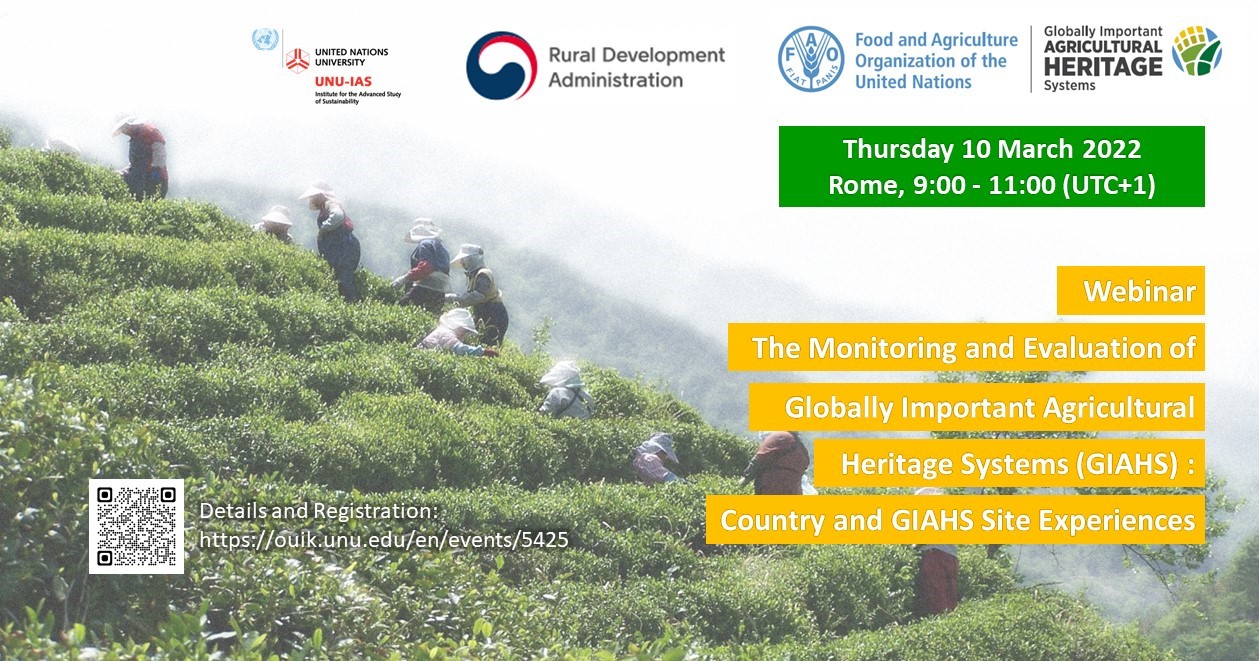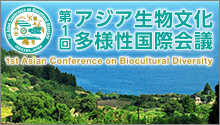Background and introduction
United Nations University Institute for the Advanced Study of Sustainability Operating Unit Ishikawa Kanazawa (UNU-IAS OUIK), Rural Development Administration of the Republic of Korea (RDA), and Food and Agriculture Organization of the United Nations (FAO) held a joint webinar, The Monitoring and Evaluation of Globally Important Agricultural Heritage Systems (GIAHS): Country and GIAHS Site Experiences, on 10 March 2022.
The event aimed to achieve two things: (1) exchange experiences and learnings from conducting monitoring and evaluation (M&E) for GIAHS, as well as discuss the opportunities and challenges of implementing an effective M&E process; and (2) launch the GIAHS Monitoring and Evaluation Manual: A Technical Reference jointly published by UNU-IAS and RDA.
The webinar was part of a four-year (2018-2022) joint research project between RDA and UNU-IAS, Introduction of Technologies on Characteristic Analysis and Conservation Management in Agricultural Heritage Systems. A total of 87 participants from 25 countries and regions attended the webinar.
Discussion
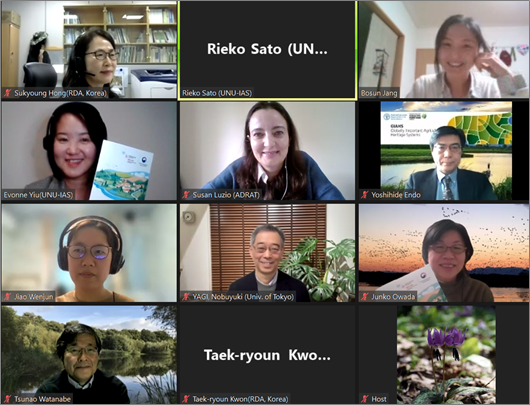
Figure 1. The webinar was held online, with a total of 87 participants from 25 countries and regions attending live.

Figure 2. Director of UNU-IAS, Prof. Shinobu Yamaguchi, opened the event.
Director of UNU-IAS, Professor Shinobu Yamaguchi, opened the event by noting the relevance of the GIAHS programme in the fast-changing society of today, marked by a “growing international interest in revaluing traditional agricultural systems as sustainable models of rural development for our planet.” She stressed that M&E must be implemented not only as an assessment exercise but also be leveraged as a “golden opportunity for the community to reaffirm the values of their GIAHS collectively.”
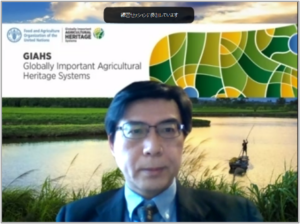
Figure 3. Mr. Yoshihide Endo from FAO kicked off the speaker presentations.
Mr. Yoshihide Endo, Global Coordinator of the GIAHS programme from FAO, further framed the conversation by providing a brief overview of the GIAHS programme. In particular he highlighted the central role of the Action Plan in the GIAHS conservation process and the role of M&E in ensuring a quality Action Plan and faithful implementation of its activities. Unfortunately, M&E currently remains an area in which many GIAHS sites lack support and technical capacity and that many GIAHS even lacked the resources to implement their Action Plan. Nonetheless, Mr Endo shared that FAO is considering to request GIAHS sites to submit report of their GIAHS M&E in the future.
Dr. Sukyoung Hong from RDA, Professor Nobuyuki Yagi from the University of Tokyo, Dr. Wenjun Jiao from the Chinese Academy of Sciences, and Ms. Susan Luzio from Associação de Desenvolvimento da Região do Alto Tâmega (ADRAT) in Portugal shared country-specific experiences from their local GIAHS.
The speakers highlighted the varying approaches to M&E, the organizational structure in which it is operationalized, and successes and challenges to date.
- Dr. Hong and Professor Yagi illustrated examples of key findings from Korean and Japanese GIAHS M&E studies, pointing out some of the common challenges they have uncovered and/or confirmed, such as depopulation and emerging effects of climate change. While noting the limitations to how much can be done in response to exogenous factors, they also guided the audience to the positive outcomes of M&E that can help mitigate challenges. They include increased coordination among GIAHS sites, unified stakeholders toward common goals, and (in the case of Korea) the empowerment of local residents through resident-participatory M&E.
- Dr. Jiao’s presentation on China’s GIAHS M&E demonstrated what a more advanced system may look like. She showed that such advancement does not signify a reduction in M&E responsibilities but calls for ongoing improvement and refinement. In China, M&E assesses (1) the state of GIAHS and (2) the management of GIAHS. She also shared a piece of practical advice that, given the reality of limited resources, M&E should be simple—that is, focused on assessing the progress in the Action Plan activities, not producing rigorous scientific research. To ensure GIAHS sites faithfully implement M&E, she urged FAO and GIAHS sites to make M&E mandatory.
- Ms. Luzio presented on a funding mechanism and organizational structure for the Barroso Agro–sylvo-pastoral System, which varied greatly from a largely government-led GIAHS programs represented by the three previous speakers. Monitoring is conducted annually by ADRAT, a non-profit entity that manages the Barroso GIAHS, which leads the coordination across relevant municipality governments and regional stakeholders.
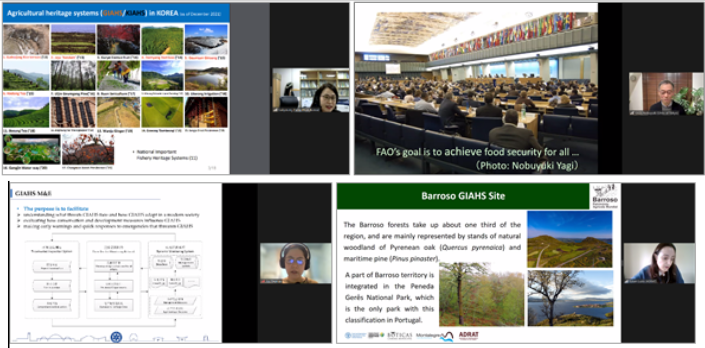
Figure 4. (From top left to the bottom right) Dr. Sukyoung Hong from RDA, Professor Nobuyuki Yagi from the University of Tokyo, Dr. Wenjun Jiao from the Chinese Academy of Sciences, and Ms. Susan Luzio from Associação de Desenvolvimento da Região do Alto Tâmega (ADRAT) in Portugal shared country-specific experiences from their local GIAHS.
The four speakers subsequently participated in a panel discussion facilitated by Dr. Evonne Yiu from UNU-IAS. The discussion transpired the following key takeaways:
- GIAHS sites should be incentivized to carry out M&E activities with financial resources and technical support. Punitive measures and pressuring GIAHS managers to provide information will not be successful; organic methods that engage the local people in the process and enable better management of the GIAHS site should be devised.
- The GIAHS programme is unique for not mandating M&E; most UN and international development initiatives require it as a condition of support.
- Should global and national guidance on GIAHS M&E be designed in the near future by FAO and member countries, the panelists stressed the importance of judiciously balancing standardized and contextualized indicators. They advised that a set of very few, simple global or national indicators around the core FAO criteria should be used to standardize expectations and ensure minimal accountability and quality assurance. Given the diversity across and unique features of GIAHS sites, however, measure of progress should be driven by local, contextualized indicators.

Figure 5. Dr. Taek-ryoun Kwon from RDA closed the event.
Closing the event was Dr. Taek-ryoun Kwon, Director General of the Technology Cooperation Bureau at RDA. He expressed gratitude for the rich discussion and uncovering the next set of conversations to be held and actions to be taken. He noted the importance of systematizing M&E and continuing partnerships and collaborations such as this webinar in realizing that collective goal.
Launching of the GIAHS Monitoring and Evaluation Manual: A Technical Reference
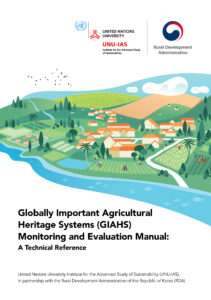
Figure 6. The GIAHS Monitoring and Evaluation Manual: A Technical Reference was officially launched during this webinar. The publication can be accessed at the UNU Collections website.
Dr. Evonne Yiu from UNU-IAS presented the GIAHS Monitoring and Evaluation Manual: A Technical Reference, newly co-published by RDA and UNU-IAS and launched officially at this webinar. The manual (1) offers technical guidance on how to design and implement an effective M&E process to support GIAHS managers and governments, and others interested in applying to GIAHS; and (2) defines role of M&E, propose principles, criteria, indicators, and core steps to design and implement an M&E process. The manual can be accessed publicly online at the UNU Collections website here.
For details, please refer to the video recording of the webinar below.


